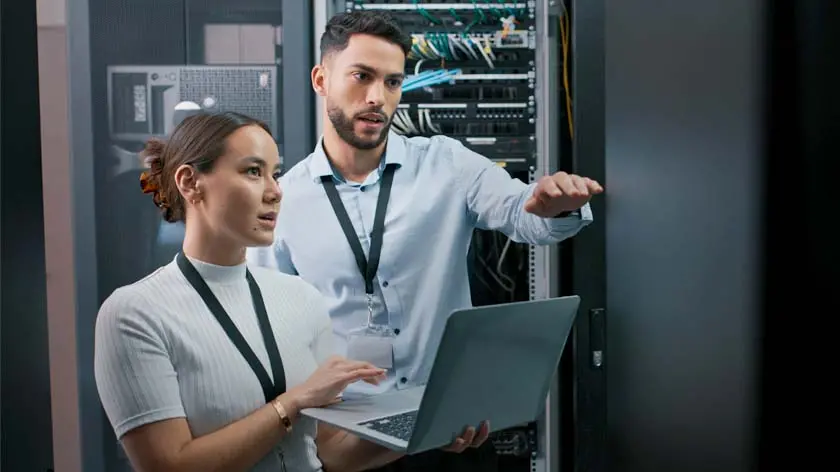Your gateway to organizational growth
Explore related insights or solutions.

Cyberthreats are on the rise, making it necessary for every organization to employ cybersecurity best practices to stay safe – and keep employees and clients protected.
Key practices include establishing a sound governance framework; protecting your computers, systems and network; and implementing and monitoring access controls.
You also want to secure your physical environments, provide enterprise-wide training, monitor vendors’ security practices and conduct incident response planning.
With the number and variety of cyberthreats continually on the rise, protecting confidential business data is now more important than ever.
In our increasingly digital world, cybersecurity and data protection have become a prominent issue for both service providers and their clients. This is particularly the case in the finance industry, where millions of financial transactions involving sensitive data are conducted daily. Understanding and implementing best practices for mitigating cybersecurity threats is crucial. Use the following cybersecurity best practices to keep your organization, employees and clients safe.
Properly protecting confidential data from cyberattacks requires a strong, intelligence-driven and risk-based security program that is backed by executive leadership and investments. This cybersecurity and data protection program should include incident response plans that must be tested regularly. Consider the National Institute of Standards and Technology (NIST) Cybersecurity Framework, which has been broadly adopted across industries. Once in place, the program must be reviewed frequently and updated accordingly.
A reliable network and system, along with computer security, is essential to protecting the confidentiality and integrity of information being processed, transmitted and retained. Anti-malware and anti-virus software should be installed on servers and workstations. This software, as well as any programs downloaded on your workstations, should be centrally managed and updated daily. Network and firewall monitoring are also key to detecting threats and preventing intrusions. Make sure your security program includes regular vulnerability assessments, penetration testing and patching protocols.
Additionally, organizations that house and transfer confidential consumer data are responsible for the security of their data transfer processes. Using multiple dedicated and encrypted networks that are actively monitored for bandwidth usage can help ensure file transfers are completed securely and effectively.
Controlling and monitoring user access to sensitive systems and data is vital to maintaining a secure environment. Keep access limited to only those who require it for essential job functions, and maintain stringent password requirements that meet industry standards. Strengthening the authentication required to use company email accounts, systems and software programs on personal devices (i.e., mobile phones, iPads, personal laptops, etc.) is particularly important as new technologies and devices are introduced. Continually monitoring the user activity of everyone with access to sensitive data helps to proactively identify any suspicious or unsafe actions.
Physical security has long been a key component to safeguarding sensitive data. It’s important for employees at all levels within an organization to engage in practices that keep physical environments secure — in facility buildings as well as at home.
While physical security measures such as utilizing a key card system to prevent unauthorized office entry are important, remote employees also need guidance on best practices to ensure that information remains secure in an at-home working environment. Taking advantage of cybersecurity technologies such as a virtual private network (VPN) can help to reduce the risk of a data breach.
Cyber criminals are evolving in their capabilities, which means that a VPN can’t only require a username and password anymore to be completely secure. Multi-factor authentication (MFA) is preferable for a protected network. Further, the strongest forms of MFA do not rely on text messages, which can be spoofed, but instead work with one-time codes generated from a token or a token application.
Criminals who carry out cyberattacks are always looking for new ways to gain access to sensitive information, and they target both individuals and organizations alike. To properly protect your company and employees from cyberthreats, it’s important to train all employees to combat cyberattacks. Demonstrated executive-level support for enterprise-wide security initiatives, such as cybersecurity awareness training, can also help you create a secure environment throughout all levels of your organization.
Phishing is a common method that cybercriminals utilize to attack organizations by attempting to access information through fraudulent emails. In fact, the 2025 AFP Payments Fraud and Control Survey Report found that over 60% of payments fraud originates from email. Conducting phishing exercises is an effective way to continuously remind employees of best practices and test for appropriate response. Possible consequences of failing these exercises can include managerial follow-up and retraining to ensure a proper response in the future. Having high employee awareness for what phishing looks like is crucial for safeguarding your company’s sensitive information.
Third-party vendors are a critical part of business operations and having a sound process in place to review them is equally as important to keep your organization running safely. When selecting vendors, ask for their SOC 2 or SSAE 18 reporting, and make sure you’re aware of how they protect client information. Conducting routine due diligence reviews helps ensure vendors are continuing to meet security requirements and helps you stay updated on any changes to services or staffing.
Conducting regular tests or exercises of your incident response plan has become increasingly important. As the environment changes, this will help determine if you need to update or change any of your procedures — ensuring your business continues to run smoothly despite times of uncertainty. This might involve establishing communications and technology for remote workers. Understanding how a situation will impact all stakeholders, internal and external, will help you to streamline these processes to meet everyone’s needs in the future.
Some events are impossible to predict but having a solid plan will protect your organization and limit damages.
Cybersecurity is a major area of concern for both businesses and individuals. Constant communication and transparency around your cybersecurity and data protection practices will help ensure your stakeholders feel comfortable. By engaging in these practices, your company can heighten your protection against cyberthreats and gain a reputation as a safe and secure organization.
At U.S. Bank, your privacy and security are our priority. We’re constantly enhancing our systems to keep your data secure and provide seamless technology experiences. To learn more about protecting your organization, schedule a meeting with U.S. Bank experts.

Explore proactive fraud prevention tools that banks have developed to help protect your organization from cyber threats.

Learn about fraud protection for payments processing your organization can implement to stay safe in the ever-evolving landscape of financial fraud.
Unlock timely, actionable strategies and perspectives from U.S. Bank experts — delivered straight to your inbox.